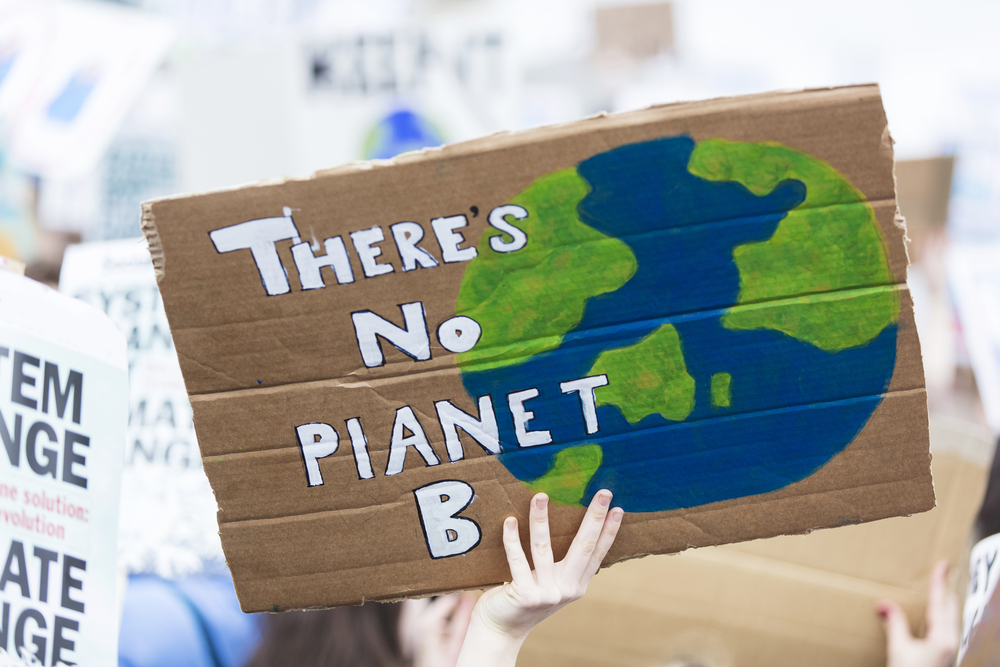Climate Activism versus Classical Liberalism at 35
By Robert L. Bradley


Philip Shabecoff, the paper’s environmental correspondent, reported on the previous day’s Senate testimony of NASA scientist James Hansen, who stated with “99 percent” confidence that the current warming trend, led by increases in atmospheric carbon dioxide (CO2) from fossil fuel combustion, was here to stay.
“If the current pace of the buildup of these gases continues, the effect is likely to be a warming of 3 to 9 degrees Fahrenheit from the year 2025 to 2050,” summarized Shabecoff. “The rise in global temperature is predicted to… melt glaciers and polar ice, thus causing sea levels to rise by one to four feet by the middle of the next century” (this century).
Thirty-five years later, the Times alarm rings exaggerated—very much so. Taking the midpoints of 6 degrees and two-and-a-half feet, with an impending start of the due date (2025), the recorded increase to date is approximately one degree and four inches.
The climate debate has been marred by exaggerated warming estimates from unreliable, biased climate models and a “deep ecology” view of nature-versus-man. The physical science of global warming only begins a multi-disciplinary debate over public policy. But far from caution and restraint in the face of unknowns and contrary evidence, climate policies have become ubiquitous. There is command-and-control at all levels of government, as well as a drive to domestically price CO2 with tariffs (“border adjustments”) to prevent leakage (business relocation to avoid domestic CO2 controls).
Classical liberals have critically assessed the case for climate alarm and the policy of forced energy transformation away from consumer-preferred fossil fuels to wind, solar, and batteries. Two notable, timeless perspectives have come from William Niskanen (1997) and Steven Horwitz (2012).
William Niskanen
In Fall 1997, political economists William A. Niskanen, then chair of the Cato Institute, published an essay against regulating (CO2) and other greenhouse gasses via a global treaty (or otherwise).2 The Kyoto Protocol was just ahead, which pitted the neo-Malthusian intelligentsia and rent-seeking corporations (such as Enron and BP) versus modern, consumer-directed high-energy living.
“In December,” Niskanen’s essay3 began, “policymakers will meet in Kyoto to discuss an international treaty to control greenhouse gases.”
- But with a dearth of knowledge about the costs, benefits, and alternatives, broad regulatory action is premature…. For this treaty to merit our support, the proponents should be asked to demonstrate the accuracy of all of the following statements:
- 1. Continued increase in the concentration of artificial greenhouse gases (primarily carbon dioxide) in the atmosphere will increase the average global temperature.
- 2. An increase in average temperature will generate more costs than benefits.
- 3. Emissions controls are the most efficient means to prevent an increase in global temperature.
- 4. Early measures to control emissions are superior to later measures, whether to control emissions or adapt to a temperature increase.
- 5. Emissions controls can be effectively monitored and enforced.
- 6. Governments of the treaty countries will approve the necessary control measures.
- 7. Controlling emissions in richer countries is desirable even if emissions in poorer countries are not controlled for several decades.
Condition #1 has in all likelihood been met, but the other six have not, making a case against government activism and for free-market adaptation. In support of Niskanen, Jerry Taylor of the Cato Institute wrote at the time4:
- There is no compelling need to act now…. There are a tremendous number of uncertainties… it would seem only prudent to continue to try to answer the open questions about climate change before making major changes to Western civilization.
Niskanen added this perspective in a ten-year look back5 (in 2008):
- With my characteristic optimism, my 1997 paper on global warming remarked that ‘We should know a lot more about this issue in the next 10 to 20 years.’ Unfortunately, there has been a rush to judgment on this issue without a significant increase in the information on which to base this judgment.
- [An] abatement strategy… will prove to be both costly and ineffective…. [A] rush to judgment on the optimal response to the increase in temperature is the greater danger [than adaptation].
Steven Horwitz
Austrian-school economist Steven G. Horwitz’s essay, “Global Warming Is About Social Science Too,”6 provided a list of essential questions to make a case for government intervention.
- 1. Is the planet getting warmer?
- 2. If it’s getting warmer, is that warming caused by humans?
- 3. If it’s getting warmer, by what magnitude?
- 4. What are the costs of global warming?
- 5. What are the benefits of global warming?
- 6. Do the benefits outweigh the costs or do the costs outweigh the benefits?
- 7. If the costs outweigh the benefits, what sorts of policies are appropriate?
- 8. What are the costs of the policies designed to reduce the costs of global warming?
The first three questions relate to physical science; the last five are for economists and other social scientists to debate.
Given physical change, Horwitz finds open questions and unsettling answers to forego a rush to government. The last question (#8) particularly spurred his interest. “Even if we design policies on the blackboard that seem to mitigate the effects of global warming,” he notes, “we have to consider, first, whether those policies are even likely to be passed by politicians as we know them, and second, whether the policies might have associated costs that outweigh their benefits.”
Continuing to public policy:
- So if in our attempt to reduce the effects of global warming we slow economic growth so far as to impoverish more people, or we give powers to governments that are likely to be used in ways having little to do with global warming, we have to consider those results in the total costs and benefits of using policy to combat global warming. This is a question of social science that is no less important than the scientific questions I began with.
“[I]t is perfectly possible to accept the science of global warming but reject the policies most often put forward to combat it,” Horwitz concluded. “One can think humans are causing the planet to warm but logically and humanely conclude that we should do nothing about it.”
Horwitz also notes that the pejorative “denier” can be used against those who commonly use the term against critics of climate alarm. “[T]hose who think they can go directly from science to policy are, as it turns out, engaged in denial – denial of the relevance of social science.”
The Debate Today
The questions and reasoning of Niskanen and Horwitz continue to define the climate debate. And at year 35, their caution against the rush to policy—now a climate road to serfdom—is only stronger.
Regarding physical science, global lukewarming is winning out over high-warming estimates from “too hot” climate models. Time-series data of weather extremes is far less than alarming. And CO2 science has documented, under controlled experiments, the benefits of carbon dioxide enrichment for agriculture and a greener earth.
Harvard economist’s Martin Weitzman’s case for climate activism (2009)7, based on “fat tail” catastrophic outcomes, has been thoroughly criticized by classical liberals—and demoted with climate models pruning back extreme scenarios.8
The mere passage of time has strengthened the case for free-market resiliency in place of governmental CO2 mitigation. Self-interested adaptation internalizes the alleged negative externalities, while greenhouse gas mitigation diminishes from the “saturation effect,” wherein increasing atmospheric concentrations reduces the forcing effect of CO2 (a logarithmic relationship).
Energy-policy-wise, the costs of government-forced transformation to dilute, intermittent, inferior energies have created energy poverty, economic decline, and power blackouts. New environmental issues have resulted from government forcing of wind and solar on the electricity grid and batteries for transportation. Consumer-preferred, taxpayer-neutral energies (oil, natural gas, and coal), meanwhile, have proven their worth under a human betterment standard.
James Hansen in Retrospect
Have the ensuing decades sullied the fear and aspirations of the father of climate alarm, James Hansen? The short answer is no, but crosscurrents in his thinking are evident. In 1998, Hansen cast doubt on his certainty of high-warming, settled science:
- The forcings that drive long-term climate change are not known with an accuracy sufficient to define future climate change. Anthropogenic greenhouse gases (GHGs), which are well measured, cause strong positive (warming) forcing. But other, poorly measured anthropogenic forcings, especially changes of atmospheric aerosols, clouds, and land-use patterns, cause a negative forcing that tends to offset greenhouse warming.9
Hansen’s critics would say this has been and still is the problem, introducing expert error.
Turning to energy substitution and public policy (social science, per Horwitz), Hansen has stated: “Suggesting that renewables will let us phase rapidly off fossil fuels in the United States, China, India, or the world as a whole is almost the equivalent of believing in the Easter Bunny and Tooth Fairy.”
In short, classical liberals can find support for their case from the leading climate activist.
Conclusion
For more on these topics, see
- Rent Seeking, by David R. Henderson. Concise Encyclopedia of Economics.
 Judith Curry on Climate Change. EconTalk.
Judith Curry on Climate Change. EconTalk. Bjorn Lomborg on the Costs and Benefits of Attacking Climate Change. EconTalk.
Bjorn Lomborg on the Costs and Benefits of Attacking Climate Change. EconTalk. Robert Pindyck on Averting and Adapting to Climate Change. EconTalk.
Robert Pindyck on Averting and Adapting to Climate Change. EconTalk.
The debate continues with classical-liberal insights in full bloom. There is the “knowledge problem” and “fatal conceit” of climate planners toward defining the problem and how to regulate, domestically and internationally. There is the reality of government (political) failure in the quest to address market failure—and government intervention expanding from its own shortcomings.
There are also the predictable problems of corporate rent-seeking and imaging in place of consumer sovereignty and fiduciary duty. Can capitalism survive?
Footnotes
[1] “Global Warming Has Begun, Expert Tells Senate.” Philip Shabecoff, Special To the New York Times, June 24, 1988.
[2] William Niskanen, “Too Much, Too Soon: Is a Global Warming Treaty a Rush to Judgment?” Jobs & Capital, Fall 1997, pp. 14–19.
[3] William Niskanen, “Too Much, Too Soon: Is a Global Warming Treaty a Rush to Judgment?” Reflections of a Political Economist (Washington, D.C: Cato Institute, 2008), p. 29.
[4] Jerry Taylor, “Clouds over Kyoto: The Debate over Global Warming,” Regulation (Winter 1998).
[5] William Niskanen, “Too Much, Too Soon,” p. 29.
[6] Steven Horwitz, “Global Warming Is About Social Science Too.” The Foundation for Economic Education, February 23, 2012.
[7] Martin Weitzman, “On Modeling and Interpreting the Economics of Catastrophic Climate Change.” Review of Economics and Statistics, 91[1], 2009.
[8] Robert P. Murphy, “The Tables Have Turned on ‘Uncertainty’ and Climate Change Policy.” Insitute for Energy Research, October 16, 2019.
[9] James Hansen, Makiko Sato, Andrew Lacis, and Elaine Mathews, “Climate forcings in the Industrial Era.” PNAS, October 27, 1998.
* Robert L. Bradley Jr. is CEO of the Institute for Energy Research (IER).
